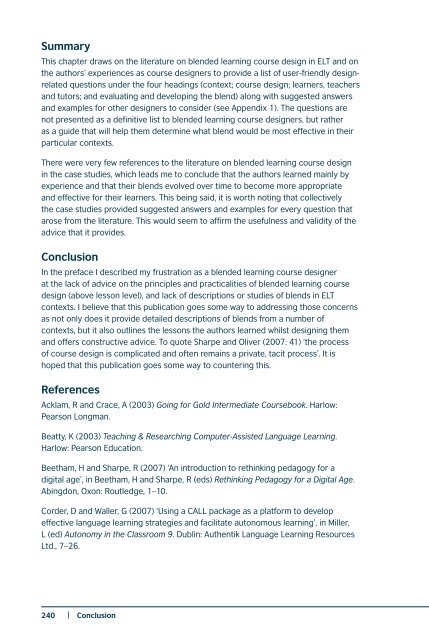Blended Learning in English Language Teaching: Course Design and Implementation
Blended Learning in English Language Teaching: Course Design and Implementation
Blended Learning in English Language Teaching: Course Design and Implementation
Create successful ePaper yourself
Turn your PDF publications into a flip-book with our unique Google optimized e-Paper software.
Summary<br />
This chapter draws on the literature on blended learn<strong>in</strong>g course design <strong>in</strong> ELT <strong>and</strong> on<br />
the authors’ experiences as course designers to provide a list of user-friendly designrelated<br />
questions under the four head<strong>in</strong>gs (context; course design; learners, teachers<br />
<strong>and</strong> tutors; <strong>and</strong> evaluat<strong>in</strong>g <strong>and</strong> develop<strong>in</strong>g the blend) along with suggested answers<br />
<strong>and</strong> examples for other designers to consider (see Appendix 1). The questions are<br />
not presented as a def<strong>in</strong>itive list to blended learn<strong>in</strong>g course designers, but rather<br />
as a guide that will help them determ<strong>in</strong>e what blend would be most effective <strong>in</strong> their<br />
particular contexts.<br />
There were very few references to the literature on blended learn<strong>in</strong>g course design<br />
<strong>in</strong> the case studies, which leads me to conclude that the authors learned ma<strong>in</strong>ly by<br />
experience <strong>and</strong> that their blends evolved over time to become more appropriate<br />
<strong>and</strong> effective for their learners. This be<strong>in</strong>g said, it is worth not<strong>in</strong>g that collectively<br />
the case studies provided suggested answers <strong>and</strong> examples for every question that<br />
arose from the literature. This would seem to affirm the usefulness <strong>and</strong> validity of the<br />
advice that it provides.<br />
Conclusion<br />
In the preface I described my frustration as a blended learn<strong>in</strong>g course designer<br />
at the lack of advice on the pr<strong>in</strong>ciples <strong>and</strong> practicalities of blended learn<strong>in</strong>g course<br />
design (above lesson level), <strong>and</strong> lack of descriptions or studies of blends <strong>in</strong> ELT<br />
contexts. I believe that this publication goes some way to address<strong>in</strong>g those concerns<br />
as not only does it provide detailed descriptions of blends from a number of<br />
contexts, but it also outl<strong>in</strong>es the lessons the authors learned whilst design<strong>in</strong>g them<br />
<strong>and</strong> offers constructive advice. To quote Sharpe <strong>and</strong> Oliver (2007: 41) ‘the process<br />
of course design is complicated <strong>and</strong> often rema<strong>in</strong>s a private, tacit process’. It is<br />
hoped that this publication goes some way to counter<strong>in</strong>g this.<br />
References<br />
Acklam, R <strong>and</strong> Crace, A (2003) Go<strong>in</strong>g for Gold Intermediate <strong>Course</strong>book. Harlow:<br />
Pearson Longman.<br />
Beatty, K (2003) Teach<strong>in</strong>g & Research<strong>in</strong>g Computer-Assisted <strong>Language</strong> <strong>Learn<strong>in</strong>g</strong>.<br />
Harlow: Pearson Education.<br />
Beetham, H <strong>and</strong> Sharpe, R (2007) ‘An <strong>in</strong>troduction to reth<strong>in</strong>k<strong>in</strong>g pedagogy for a<br />
digital age’, <strong>in</strong> Beetham, H <strong>and</strong> Sharpe, R (eds) Reth<strong>in</strong>k<strong>in</strong>g Pedagogy for a Digital Age.<br />
Ab<strong>in</strong>gdon, Oxon: Routledge, 1–10.<br />
Corder, D <strong>and</strong> Waller, G (2007) ‘Us<strong>in</strong>g a CALL package as a platform to develop<br />
effective language learn<strong>in</strong>g strategies <strong>and</strong> facilitate autonomous learn<strong>in</strong>g’, <strong>in</strong> Miller,<br />
L (ed) Autonomy <strong>in</strong> the Classroom 9. Dubl<strong>in</strong>: Authentik <strong>Language</strong> <strong>Learn<strong>in</strong>g</strong> Resources<br />
Ltd., 7–26.<br />
240<br />
| Conclusion


